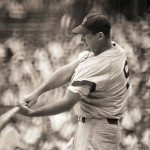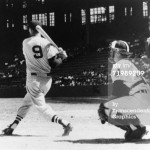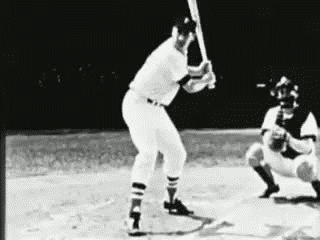Ted Williams said it best for all of us who have ever played the game of Baseball, as well as participated in other forms of athletics, “hitting a baseball is the single-most difficult thing to do in all of sports.” No other individual sport-skill encompasses the variety of challenging variables that a batter has to “put in order” to be a proficient “hitter.” 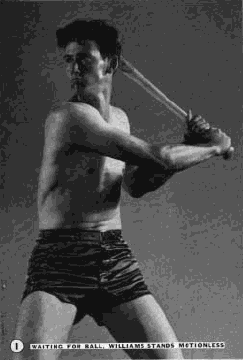 It takes physical strength, flexibility, quickness, and timing, as well as the mental attributes of courage, confidence, determination, fortitude, for even the least skilled professional to “stand-in” against a 95 M.P.H. fastball, or 85+slider. When all the off-speed multiples are added in, one might wonder why the Defense Department doesn’t make “Batting 444” a pre-requisite for the highest combat-training courses.
It takes physical strength, flexibility, quickness, and timing, as well as the mental attributes of courage, confidence, determination, fortitude, for even the least skilled professional to “stand-in” against a 95 M.P.H. fastball, or 85+slider. When all the off-speed multiples are added in, one might wonder why the Defense Department doesn’t make “Batting 444” a pre-requisite for the highest combat-training courses.
Now, to become an outstanding hitter, an individual must develop all the aforementioned characteristics, as well as ascribe to a technique of proper mechanics which facilitates the most probable means of making solid contact with a pitched baseball. And, of course solid contact would have to involve more than just striking the ball squarely with the bat! A player could hit the ball squarely off the bat, and merely hit a bouncing ball or even a hard ground ball to an infielder for a sure out. 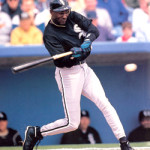
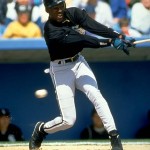 And sometimes he could hit a ball squarely, and launch a towering “pop-up,” or “hook” a wicked foul-ball.
And sometimes he could hit a ball squarely, and launch a towering “pop-up,” or “hook” a wicked foul-ball.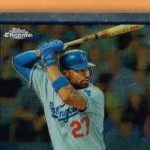
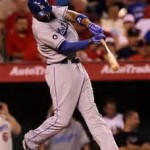

However, a “good hitter” is not merely one who makes solid contact with the ball. But rather, he is a batter whose body mechanics facilitate the action of the swinging bat to contact and continue through the ball at an angle that provides for a straight (non-hooking or slicing) and ascending “line-drive.” The “Art” of hitting a baseball could certainly be defined in the context of describing the ideal hitter– “He is one whose bat most consistently contacts and drives through the ball in a manner that facilitates a straight and ascending “line-drive.”(To hit the ball in any other manner would be to miss-hit it.)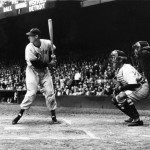
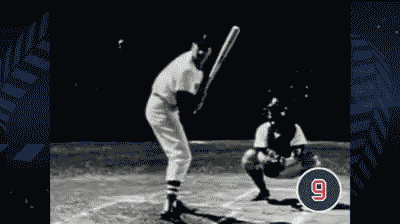
Ted Williams must have been speaking for the Superlative degree when he made his famous, yet arguable, declaration that “Hitting a baseball is the single-most difficult thing to do in all of Sports.” Just hitting the pitched ball is not that difficult to do; hitting it with authority is what is difficult! Because of the myriad challenges a batter has to surmount while encountering the diminutive, ballistic (and frequently volatile), compressed, spherical projectile, most dispassionate and well-rounded athletes would agree that making solid and forceful contact with a bat to a pitched ball takes extraordinary, and nearly uncanny, skill.
The best hitters in Baseball either consciously, or unconsciously, ascribed to sound basics principles in their batting application. But even they should aspire to diminish the substandard quotient for presumable batting excellence, by eliminating those margins for error which plague every erstwhile (but ignorant) proponent for exceeding the 40percentile range of batting efficiency.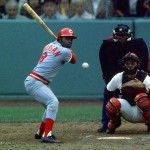
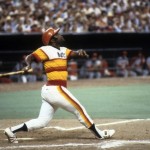
Two basic ideas have to be present in the thought of every batter as he contemplates the proper batting technique. First, he must fully realize the fact that every pitch is moving in a downward trajectory.An intelligent approach to the ball would obviously have to incorporate body movement that would facilitate the flight action of the bat to be one in a slightly upward direction as it is contacting the ball on a line as close to 180 degrees as possible. Second, optimal viewing of the pitched baseball is achieved when the batter’s head is still, and eyes remain as close as possible to a parallel level of the ball, as the swing is taking place.Since it is impossible for the batter’s eyes to be at a parallel level with any pitch within the strike zone, maintaining a low stance not only provides a batter with a more advantageous accommodation for the umpire’s strike-zone, but also affords him an optimal viewing angle from which to more accurately detect the nuances (speed and direction) of the incoming ball.
There are three basic components to the practical application of the principle of effective batting: (1) Balance and Stability of Stance; (2) Security for undisturbed visual acuity; (3) Self-contained Power source.
A low center of gravity can be established by spreading the feet to the length of one’s normal stride, and bending the knees as low as can accommodate comfort and quickness. This strong base affords the batter the fastest possible reaction time for a twisting body to respond to any variation of pitched balls. One of the most prominent features of a low stance is the obvious advantage the batter has with the establishment of a smaller strike zone.
With the low-wide stance, the batter is in an “ultra-stationary” position, from which to view the pitched ball with a minimum of distortion. As a tennis player receiving serve, a catcher receiving a pitch, a shortstop receiving a throw from catcher, and a first baseman receiving low throws from infielders are bent over and down as low as they can, to see the speeding ball on as close to a parallel level to the eyes as possible, so the batter, in a low stance, views the pitched ball with most clarity.
Although Mr. Williams was nearly perfect in his understanding and application of the principles governing the absolute definition of batting prominence, he was not altogether unflawed in his actual approach to an impeccable demonstration. The closest exponent of the perfect batting technique was Barry Bonds, who, in obvious ways, superseded the brilliance that Ted Williams embodied.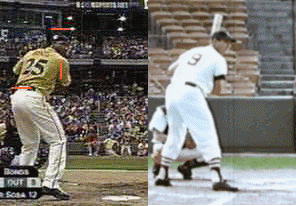
Barry Bonds was capable of hitting 100 home runs and batting .400 or more, because he was closer to flawless technique than anyone who has ever played the game. His strength was incontestable, his athletic ability was indisputable, his timing was nearly impeccable, and his stance, approach to the ball, and fluid mechanics were incomparable. In the few areas in which Ted Williams appeared lacking, Mr. Bonds was pronouncedly adept (especially in his adaptability to strike at the low pitch, and hitting the ball with power to the opposite field).
What was it that Barry Bonds did consistently right, that most, if not all, other batters do only sporadically? The answer is 5 separate things. They are the following: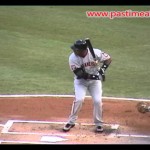
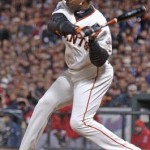
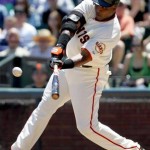
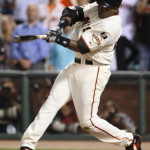

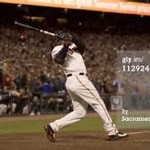

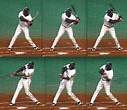
- He established a strong low center of gravity while waiting for the ball.
- He greatly diminished the movement of his head and eyes.
- He waited patiently for the ball to get to him while he quietly lowered his hands to begin an unobtrusive rhythm of his arms.
- When the ball got to his hitting zone, 4 things happened simultaneously:
a. The front foot planted quickly and firmly—front leg straightened
- Front shoulder shrugged upward, while back shoulder and elbow drove downward (hands, while staying behind back shoulder, present a flat bat as the body was turning to address the pitched ball).
- Back bent knee drove forward and down, as hips turned rapidly
- The shoulders followed the hips in rapid succession with arms extending through the contact of the ball.
- From contact, through the straightening of arms, through the follow through, the shoulders were continuously flowing, until they (shoulders) had changed position (back to front and vice-versa).
If ever there was an “ideal” to emulate as advised by Aristotle’s Nichomachian Ethics, and to form a generic “designation” for a universal application for batting a baseball, it would have to be Barry Bonds. Consistency of batting effectiveness (efficiency in striking a baseball) had never been more highly demonstrated than by Barry Bonds, in the 2001season, as well as in 2002—2004. Throughout his Major League career, accolades were heaped upon him for what seemed like a remarkable consistency for slugging the ball better than anyone else, at least in the 1990s.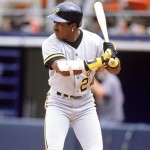

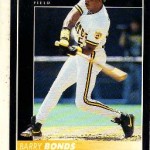

It was neither strength, nor natural ability, which allowed Barry to stand out as the greatest exponent of Batting Excellence the Baseball World had ever seen. It was his masterful application of the basic fundamentals of Principle that afforded him the facility to near impeccable demonstration. He was the only hitter who came to the plate, and looked as though he should get a hit every time he swung the bat. I’m sure that even Shakespeare would exclaim, “O thou, Faithful Consistency, but by any other name, thou art Barry Bonds.” – And Einstein would concur!
Coming Soon: Is a Team Equal, or Greater, than the Sum of Its Parts? Part 1 of 3
